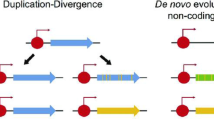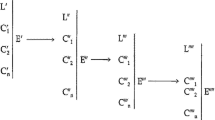Abstract
Much of the recent philosophical debate on causation and causal explanation in the biological and biomedical sciences has focused on the notion of mechanism. Mechanisms, their nature and epistemic roles have been tackled by a range of so-called neo-mechanistic theories, and widely discussed. Without denying the merits of this approach, our paper aims to show how lately it has failed to give proper credit to processes, which are central to the field, especially of contemporary molecular biology. Processes can be summed up in the notion of ‘pathway’, which is far from being just equivalent to that of ‘mechanism’ and has a profound epistemological and explanatory relevance. It is argued that an adequate consideration of pathways impels some rethinking of scientific explanation in molecular biology, namely its functional and contextual features. A number of examples are given to suggest that the focus of philosophical attention in this disciplinary field should shift from the notion of mechanism to the notion of pathway.
Similar content being viewed by others
Notes
A wide survey of neo-mechanism as a philosophical movement is provided in Glennan and Illari (2017a).
Such features as isolability, organization and sequentiality are taken to situate processes along some “multidimensional gradient”. This is opposed to an analysis on the basis of discrete entities (Skillings 2015, p. 1140).
Discussing biomedical discovery, Paul Thagard too states: “biochemical pathways are a kind of mechanism. […] In biochemical pathways, the entities are the molecules and the activities are the chemical reactions that transform a molecule into other molecules” (2002, pp. 237–238, italics added).
According to Ioannides and Psillos, the three major metaphysical accounts of mechanisms nowadays are Machamer et al. (2000), Glennan’s (2002) and Bechtel and Abrahamsen’s (2005). We already introduced Glennan’s most recent definition above, and will refer to the other two works below. Psillos’ work on mechanistic causation has not only addressed most recent theories and trends, but also thoroughly investigated the historical roots of the philosophy of mechanisms. See e.g. Psillos (2011).
Dowe’s account has been amended in Boniolo et al. (2011).
On the suggestion of an overall rethinking of the living world in processual terms, up to a renewed philosophy of biology, see Dupré and Nicholson (forthcoming). For some arguments against the metaphysical replacement of mechanisms with processes, see Austin (2016).
We are far from denying that functions have also been addressed within philosophical discussions of mechanisms. Just to recall some very recent work, Justin Garson (2017), e.g., stresses that mechanisms are sometimes described in terms of their functions. However, he remains faithful to the notion of mechanism: “the class of functional mechanisms is [taken as] an interesting proper subset of the class of minimal mechanisms” (Garson 2017, p. 105), where “minimal mechanisms” are understood according to Glennan’s (2017) definition. We hence believe that this analysis is not immune to the shortcomings of the far too broad notion of minimal mechanism.
As is known, many genes and the encoded proteins have different names. We follow the nomenclature indicated by the HUGO Gene Nomenclature Committee, (www.genenames.org).
Melanoma, as is known, is a type of skin cancer. MAPK is a mitogen-activated protein kinase (originally called ERK—extracellular signal-regulated kinase—as in the figure) and PI3 K is another protein: phosphatidylinositol-4,5-bisphosphate 3-kinase.
c-KIT is a tyrosine kinase receptor and RAS (Rat sarcoma protein) is a serine/threonine-protein kinase.
Commenting on that, Dupré continues: “The problem with this kind of teleological system, or system with a robust tendency to end up in particular preferred states, is that the relation between functions and mechanisms is more complex than that supposed by standard mechanistic theories” (ibidem).
Amongst most recent works on this, see e.g. Darden et al. (2018).
References
Austin CJ (2016) The ontology of organisms: Mechanistic models or patterned processes? Biol Philos 31:639–662
Bechtel W, Abrahamsen A (2005) Explanation: mechanist alternative. Stud Hist Philos Biol Biomed Sci 36:421–441
Bechtel W, Richardson R (1993) Discovering complexity. Princeton University Press, Princeton
Boniolo G, Lanfrancone L (2016) Decomposing biological complexity into a conjunction of theorems. The case of the melanoma network. Humana.Mente. J Philos Stud 30:19–35
Boniolo G, Di Fiore PP, D’Agostino M (2010) Zsyntax: a formal language for molecular biology with projected applications in text mining and biological prediction. PLoS ONE 5:e9511. https://doi.org/10.1371/journal.pone.0009511
Boniolo G, Faraldo R, Saggion A (2011) Explicating the notion of ‘causation’: the role of the extensive quantities. In: Illari P, Russo F, Williamson J (eds) Causality in the sciences. Oxford University Press, Oxford, pp 502–525
Boniolo G et al (2013) A logic of non-monotonic interactions. J Appl Logic 11:52–62
Boniolo G et al (2015) Adding logic to the toolbox of molecular biology. Eur J Philos Sci 5:399–417
Bray SJ (2016) Notch signalling in context. Nat Rev Mol Cell Biol 17:722–735
Craver C (2001) Role functions, mechanisms and hierarchy. Philos Sci 68:53–74
Craver C (2006) When mechanist models explain. Synthese 153:355–376
Craver C, Darden L (2013) In search of mechanisms. University of Chicago Press, Chicago
Darden L (2008) Thinking again about mechanisms. Philos Sci 69:S354–S365
Darden L et al (2018) The product guides the process: discovering disease mechanisms. In: Danks D, Ippoliti E (eds) Building theories. Springer, Dordrecht, pp 101–118
Dowe P (2000) Physical causation. Oxford University Press, Oxford
Dupré J (2013) Living causes. Proceedings of the Aristotelian Society Supplementary Volume LXXXVII, https://doi.org/10.1111/j.1467-8349.2013.00218.x
Dupré J, Nicholson D (forthcoming) A manifesto for a processual philosophy of biology. In: Nicholson D, Dupré J (eds) Everything flows: towards a processual philosophy of biology. Oxford University Press, Oxford
Egloff AM, Grandis JR (2012) Molecular pathways: context-dependent approaches to Notch targeting as cancer therapy. Clin Cancer Res 18(19):5188–5195. https://doi.org/10.1158/1078-0432.ccr-11-2258
Franklin-Hall L (2016) New mechanistic explanation and the need for explanatory constraints. In: Aizawa K, Gillett C (eds) Scientific composition and metaphysical ground. Palgrave MacMillan, Basingstoke, pp 41–74
Garson J (2017) Mechanisms, phenomena, and functions. In: Glennan S, Illari P (eds) The Routledge handbook of mechanisms and mechanical philosophy, pp 104–103
Giovannetti E et al (2013) Molecular mechanisms and modulation of key pathways underlying the synergistic interaction of sorafenib with erlotinib in non-small-cell-lung cancer (NSCLC) cells. Curr Pharm Des 19:927–939
Glennan S (2002) Rethinking mechanistic explanation. Philos Sci 69:S342–S353
Glennan S (2017) The new mechanical philosophy. Oxford University Press, Oxford
Glennan S, Illari P (eds) (2017a) The Routledge handbook of mechanisms and mechanical philosophy. Routledge, London
Glennan S, Illari P (2017b) Varieties of mechanisms. In: Glennan S, Illari P (eds) The Routledge handbook of mechanisms and mechanical philosophy. Routledge, London, pp 91–103
Hitchcock C (2004) Causal processes and interactions: What are they and what are they good for? Philos Sci 71:932–941
Illari P, Williamson J (2012) What is a mechanism? Thinking about mechanisms across the sciences. Eur J Philos Sci 2:119–135
Ioannidis S, Psillos S (2017) In defense of methodological mechanism. Axiomates 27:601–619
Kimball SR, Jefferson LS (2016) Signaling pathways and molecular mechanisms through which branched-chain amino acids mediate translational control of protein synthesis. J Nutr 136:227S–231S
Lan A, Ziv-Ukelson M, Yeger-Lotem E (2013) A context-sensitive framework for the analysis of human signalling pathways in molecular interaction networks. Bioinformatics 29:i210–i216
Levy A (2013) Three kinds of new mechanism. Biol Philos 28:99–114
Machamer P, Darden L, Craver C (2000) Thinking about mechanisms. Philos Sci 67:1–25
Nethi SK et al (2015) Investigation of molecular mechanisms and regulatory pathways of pro-angiogenic nanorods. Nanoscale 7:9760–9770
Nicholson D, Dupré J (eds) (forthcoming) Everything flows: towards a processual philosophy of biology. Oxford University Press, Oxford
Nosrati N et al (2017) Molecular mechanisms and pathways as targets for cancer prevention and progression with dietary compounds. Int J Mol Sci 18:2050
Piccinini G, Craver C (2011) Integrating psychology and neuroscience: functional analyses as mechanism sketches. Synthese 18:283–311
Psillos S (2011) The idea of mechanism. In: Illari P, Russo F, Williamson J (eds) Causality in the sciences. Oxford University Press, Oxford, pp 771–788
Rosenberg A (2018) Making mechanism interesting. Synthese 195:11–33
Salmon W (1984) Scientific explanation and the causal structure of the world. Princeton University Press, Princeton
Salmon W (1989) Four decades of scientific explanation. In: Kitcher P, Salmon W (eds) Scientific explanation, vol XIII. Minnesota Studies in the Philosophy of Science, Minneapolis, pp 3–219
Salmon W (1998) Causality and explanation. Oxford University Press, Oxford
Salmon W (2002) A realistic account of causation. In: Marsonet M (ed) The problem of realism. Ashgate, Aldershot, pp 106–134
Schwanbeck R, Martini S, Bernoth K (2011) The Notch signaling pathway: molecular basis of cell context dependency. Eur J Cell Biol 90:572–581
Skillings DJ (2015) Mechanistic explanation of biological processes. Philos Sci 82:1139–1151
Thagard P (2002) Pathways to biomedical discovery. Philos Sci 70:235–254
Wang Z et al (2016) The molecular mechanism and regulatory pathways of cancer stem cells. Cancer Transl Med 2:147–153
Acknowledgments
We would like to thank the referees and J. Dupré for their very useful comments on a previous version of this paper.
Author information
Authors and Affiliations
Corresponding author
Rights and permissions
About this article
Cite this article
Boniolo, G., Campaner, R. Molecular pathways and the contextual explanation of molecular functions. Biol Philos 33, 24 (2018). https://doi.org/10.1007/s10539-018-9634-2
Received:
Accepted:
Published:
DOI: https://doi.org/10.1007/s10539-018-9634-2




